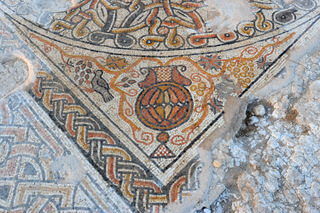The mosaic attributed to the 6th-4th centuries AD was uncovered in recent weeks during salvage excavations in the fields of Kibbutz Beit Kama in the Bnei Shimon Regional Council. The mosaic was discovered as part of an archaeological dig conducted by the Antiquities Authority prior to the construction of an interchange

A magnificent colorful mosaic dating from the 6th-4th centuries AD was uncovered in recent weeks in the fields of Kibbutz Beit Kama in the Bnei Shimon Regional Council. The mosaic was discovered as part of an archaeological excavation conducted by the Antiquities Authority prior to the construction of an interchange in the section between Mahaz and the Davira intersection by the Cross Israel Highway Company and in Maimona.
In the excavation, which is being carried out in the agricultural fields of the kibbutz and is managed by Dr. Rina Avner from the Antiquities Authority, the remains of a settlement were discovered, which covers an area of more than 6 dunams.
The main building on the site was a large hall, 12 m long and 8.5 m wide, and it seems that its ceiling was covered with tiles. The impressive entrance to the hall, and the magnificent mosaic that decorates its floor, suggest that the place was used as a public building.
The mosaic, which was well preserved, is decorated with geometric patterns, and in its corners are amphorae (jugs used to transport wine), a pair of peacocks, and a pair of pigeons pecking grapes from a vine. These models are common and well-known from this period, but the uniqueness of the mosaic is a large number of motifs that were combined in one carpet.
In front of the building, pools of water were discovered and between them a system of canals and pipes for carrying water. One of them has stairs, and its walls are decorated with colored plaster (fresco).
The Antiquities Authority is still investigating what the impressive public building was used for, and the water pools, in which considerable financial resources were invested.
It seems that the site, which sat on an ancient road that led north from Be'er Sheva, housed a large estate - with a church, residential buildings and storage rooms, a large storage cistern for water, a storage building and water ponds surrounded by agricultural areas. It is possible that one of the buildings was used as a hostel for passers-by who frequented the place.
.
During the Byzantine period, Jewish and Christian settlements lived side by side in the area. Among the Jewish settlements - the ruins of Rimon, where a synagogue and a purification mikva were uncovered, and the Nahal Shovel site that was recently excavated following the construction of the Trans-Israel road, where purification mikvas were uncovered. Among the Christian settlements - Abu Hoof churches in the Lahav forest, and the monastery in Givat Bar.

3 תגובות
The place is east of the road in front of Beit Kama intersection
It is interesting to see settlements that were large and developed in the area that disappeared without leaving a name. In addition, in my opinion, these settlements show that in the past it was more rainy, otherwise they could not have existed.
Who knows how to come see the place?
Is it possible to determine whether the settlement was Jewish or Christian, or is it too early?
It is likely that this was a religious building, and if this is a Jewish settlement, then it is possible that the water pools were used as a purification mikvah.